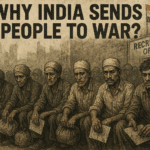A Port of Shadows
Imagine Karachi in the early 1800s. Its port was not yet the bustling metropolis we know today, but a small coastal town with wooden dhows anchored offshore, their sails fluttering in the Arabian Sea breeze. Amid the smells of spices, dates, and pearls, another kind of trade thrived — one far darker. Men, women, and children, their wrists bound with ropes, were marched through the sandy streets, their fates decided in the slave markets. This was the story of Sindh’s African slaves, a chapter that remains hidden in the larger narrative of South Asian history.
Roots of the Indian Ocean Slave Trade
While the transatlantic slave trade has dominated global memory, the Indian Ocean carried its own forgotten horrors. From the late 17th to mid-19th century, Oman’s domination of Zanzibar and the Swahili Coast turned East Africa into a vast hunting ground. Raiding parties stormed villages, capturing the young and strong, selling them as “black ivory” — a chilling metaphor equating human lives to precious commodities.
Karachi, under the Talpurs, became one of the major depots of this trade. Slaves captured in Africa first passed through Muscat, Oman, and from there were ferried to Karachi, where they were sold to Sindhi merchants, feudal lords, and fishermen.
Karachi as a Slave Hub
British officer Commander Carless recorded that in 1837 alone, over 1,500 slaves landed in Karachi. Prices ranged from 60 to 100 rupees for Sheedi men, while Abyssinian women — called Hubshees — fetched up to 500 rupees if they were considered exceptionally beautiful. The Talpurs even taxed the trade, charging a levy on each slave sold in the city.
The slave trade reached its peak in the 1830s, ironically because the British had already outlawed slavery in much of India. Sindh, still outside British control, became a convenient loophole for Arab traders.
Categories and Social Roles
Unlike the Atlantic trade, where men were prized for plantation labor, Karachi’s market saw greater demand for women and children. Sheedi boys were considered ideal apprentices for fishermen — agile, intelligent, and fearless at sea. Men worked as guards, laborers, and agricultural hands on Talpur lands. Women were absorbed into households as domestic workers, concubines, and even entertainers.
Local classifications reflected both origins and social hierarchies:
-
Sheedi – general name for African-origin slaves.
-
Hubshee – Abyssinians, considered elite.
-
Makranis – a mix of African and Baloch heritage from the Makran coast.
-
Gaado – children born to slave mothers and Sindhi men.
-
Qambrani – descendants of Gaado women and Sindhi elites, named after Hazrat Ali’s famous freed slave Qambar.
Life, Culture, and Identity
Despite the brutality of their capture, life in Sindh offered a curious paradox. Many European travelers noted that slaves in Sindh were treated “like members of the family.” Richard Burton described their love for music and dance, noting their wild yet joyful performances at the shrine of Mangho Pir.
At these shrines, Sheedis drummed on the mugarman, sang in a mix of Swahili and Arabic, and celebrated rituals that fused African memory with Sindhi spirituality. This unique cultural identity became their form of survival — a way of resisting erasure.
Resistance and Heroism
Not all slaves accepted their fate quietly. Some rose to prominence, none more so than Hoshu Sheedi, the African-origin general who fought valiantly against the British in 1843. His defiant cry, “Mar vesoon, par Sindh na desoon” (I may die, but I will not surrender Sindh), still echoes as a symbol of Sindhi resistance.
Another legacy was left by Muhammad Siddiq Musafir, son of a Zanzibari slave, who became a celebrated writer and educator in Sindh, authoring over a hundred books. Their stories reveal how enslaved people transformed into voices of freedom and culture.
The Aftermath of Abolition
When the British annexed Sindh in 1843, they officially outlawed slavery. Yet, freedom was bittersweet. Many Sheedis remained with their former masters as servants, bound more by economics than chains. Others settled in Karachi’s Lyari, which became a vibrant hub of the Afro-Sindhi community.
Lyari turned into a melting pot: Makranis, Lasis, and Kutchis mingled with Sheedis, creating a unique neighborhood defined by resilience. They worked as dock laborers, donkey cart drivers, and fishermen — the invisible workforce behind Karachi’s growth.
Survival Through Culture
Even in poverty, Sheedis preserved fragments of their African heritage. Their drumming, dances, and chants remain integral to festivals at Mangho Pir. Women, in particular, emerged as cultural custodians — bold, outspoken, and politically active. In Lyari, Sheedi women became symbols of defiance, dancing in the streets to celebrate political victories when others could not.
Legacy and Lessons
Today, the Sheedis of Karachi and Sindh remain among the most marginalized communities, living in cramped quarters of Lyari, often denied the privileges promised by independence. Yet, their story is not one of despair but of survival. They turned slavery’s scars into cultural resilience, embedding African rhythm, language, and pride into Sindh’s identity.
The history of Sindh’s African slaves is more than a footnote. It is a reminder that Karachi’s foundations were not only built on trade and conquest, but also on the resilience of those who arrived in chains and carved out a life of dignity, memory, and song.
The forgotten voices of Sindh’s slaves whisper through Lyari’s alleys, through the drumbeats at Mangho Pir, and through the proud resilience of Sheedi women. To tell their story is not just history — it is justice.












